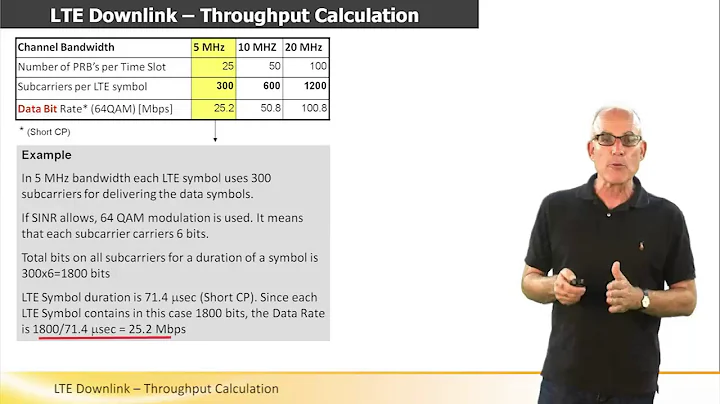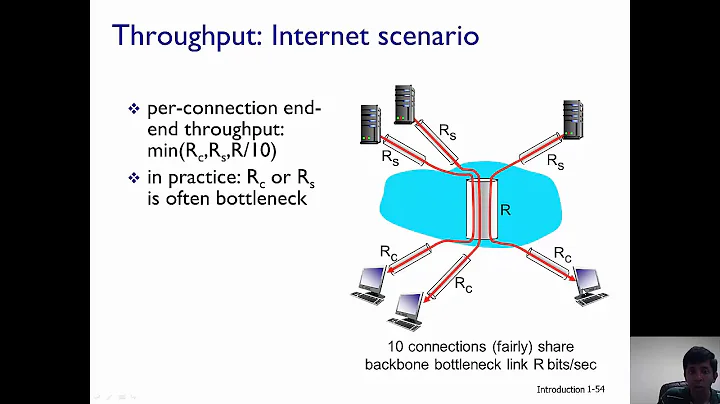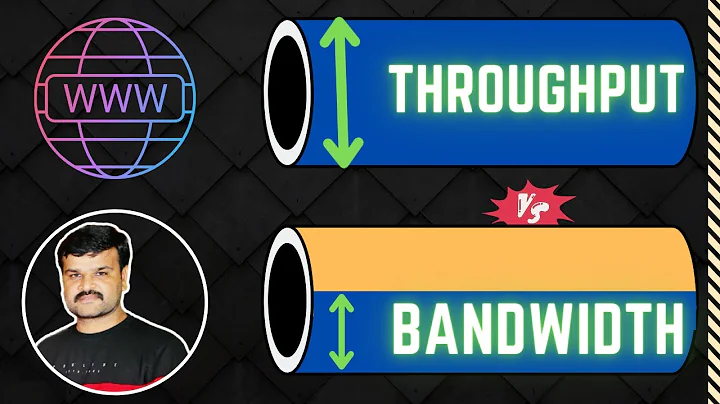Proper way to calculate Link Throughput
Solution 1
What is the proper way to calculate throughput?
There are multiple ways, depending on what exactly you want to measure. They all boil down to dividing some number of bits (or bytes) to some duration, as you mention; what varies is which bits you are counting or (more rarely) which moments of time you are considering for measuring the duration.
The factors you need to take into account are:
At which layer in the network stack are you measuring throughput?
If you measure at the application layer, all that matters is what useful data you transmit to the other endpoint. For example, if you are transferring a file of 6 kB, the amount of data you count when measuring throughput is 6 kB (that is 6,000 bytes, not bits, and note the multiplier of 1000, not 1024; these conventions are common in networking).
This is usually called goodput and it may be different from what is actually sent at the transport layer (as in TCP or UDP), for two reasons:
1. Overhead due to headers
Each layer in the network adds a header to the data that introduces some overhead due to its transmission time. Moreover, the transport layer breaks your data into segments; this is because the network layer (as in IPv4 or IPv6) has a maximum packet size called MTU, typically 1,500 B in Ethernet networks. This value includes the network layer header size (e.g. the IPv4 header, which is variable in length but usually 20 B long) and the transport layer header (for TCP, it is also variable in length but usually 40 B long). This leads to a maximum segment size MSS (number of data bytes, without headers, in one segment) of 1500 - 40 - 20 = 1440 bytes.
Thus if we want to send 6 kB of application-layer data, we must break it into 6 segments, 4 of 1440 bytes each and one of 240 bytes. However at the network layer we end up sending 6 packets, 4 of 1500 bytes each and one of 300 bytes, for a total of 6.3 kB.
Here I have not considered the fact that the link layer (as in Ethernet) adds its own header and possibly also a suffix, which increases the overhead further. For Ethernet this is 14 bytes for the Ethernet header, optionally 4 bytes for VLAN tag, then a CRC of 4 bytes and a gap of 12 bytes, for a total of 36 bytes per packet.
If you consider a fixed-rate link, say of 10 Mb/s, depending on what you measure you will get a different throughput. Normally you want one of these:
- The goodput, i.e. application layer throughput, if what you want to measure is application performance. For this example, you divide 6 kB by the transfer duration.
- The link-layer throughput, if what you want to measure is network performance. For this example, you divide 6 kB + TCP overhead + IP overhead + Ethernet overhead = 6.3 kB + 5 * 36 B = 6516 B by the transfer duration.
Retransmission overheads
The Internet is a best-effort network, meaning that the packets will be delivered if possible, but may also be dropped. Packet drops are corrected by the transport layer, in case of TCP; for UDP, there is no such mechanism, which means that either the application does not care if some parts of the data do not get delivered, or the application implements retransmission itself on top of UDP.
Retransmission reduce goodput for two reasons:
a. Some data needs to be sent again, which takes time. This introduces a delay which is inversely proportional to the rate of the slowest link in the network between the sender and the receiver (a.k.a the bottleneck link). b. Detecting that some data was not delivered needs feedback from the receiver to the sender. Due to propagation delays (sometimes called latency; caused by the finite speed of light in the cable), feedback can only be received by the sender with some latency, which slows down the transmission even more. In most practical cases, this is the most significant contribution to the extra delay caused by the retransmission.
Clearly, if you use UDP instead of TCP and you do not care about packet loss, you will of course get better performance. But for many applications, data loss cannot be tolerated, so such a measurement is meaningless.
There are some applications that do use UDP for transferring data. One is BitTorrent, which may use either TCP or a protocol they designed called uTP, which emulates TCP on top of UDP, but aims at being more efficient with many parallel connections. Another transport protocol implemented over UDP is QUIC, which also emulates TCP and offers multiplexing multiple parallel transfers over a single connection, and forward error correction to reduce retransmissions.
I will discuss forward error correction a little since it is related to your question about throughput. A naive way of implementing it is by sending every packet twice; in case one gets lost, the other still has a chance of being received. This reduces the amount of retransmissions to half, but also halves your goodput since you send redundant data (note that the network or link layer throughput remains the same!). In some cases this is fine; especially if the latency is very large, such as on intercontinental or satellite links. Moreover, some mathematical methods exist where you don't have to send a full copy of the data; for instance for every n packets you send, you send another reduntant one which is the XOR (or some other arithmetic operation) of them; if the redundant one gets lost, it doesn't matter; if one of the n packets gets lost, you can reconstruct it based on the redundant one and the other n-1. You can thus configure the overhead introduced by forward error correction to whatever amount of bandwidth you can spare.
How you are measuring the transfer time
Is the transfer completed when the sender finished sending the last bit over the wire, or does it also include the time it takes for the last bit to travel to the receiver? Additionally, does it include the time it takes to get a confirmation from the receiver, stating that all data has been received successfully and no retransmission is neede?
It really depends on what you want to measure. Note that for large transfers, one extra round-trip-time is insignificant in most cases (unless you are communicating, for instance, with a probe on Mars).
What is that key feature in TCP that makes it have much much higher throughput than UDP?
This is not true, although a common misconception.
In addition to retransmitting data when needed, TCP will also adjust its sending rate so that it will not cause packet drops by congesting the network. The adjustment algorithm has been perfected over decades, and usually converges quickly to the maximum rate supported by the network (actually, the bottleneck link). For this reason it is usually difficult to beat TCP in throughput.
With UDP, there is no rate limiting at the sender. UDP lets the application send as much as it wants. But if you try to send more than the network can handle, some of the data will be dropped, lowering your throughput, and also making the admin of the network you are congesting very angry. This means that sending UDP traffic at high rates is impractical (unless the goal is to DoS a network).
Some media applications are using UDP but rate-limiting the transfer at the sender at a very small rate. This is typically used in VoIP applications or Internet Radio, where you require very little throughput but low latency. I suppose this is one of the reasons for the misconception that UDP is slower than TCP; that is not the case, UDP can be as fast as the network allows.
As I said before, there are protocols such as uTP or QUIC, implemented over UDP, which achieve performance similar to TCP.
Is this true ?
TCP throughput = (TCP Window Size / RTT)
Without packet loss (and retransmissions), this is correct.
TCP throughput = BDP / RTT = (Link Speed in Bytes/sec * RTT)/RTT = Link Speed in Bytes/sec
This is correct only if the window size is configured to the optimal value. BDP/RTT is the optimal (maximum possible) transfer rate in the network. Most modern operating systems should be able to auto-configure it optimally.
How is throughput dependent on Block size ? Is Block size equals TCP window or UDP datagram size?
I don't see any block size in the iperf documentation.
If you refer to the TCP window size, if it is smaller than BDP, then your throughput will be suboptimal (because you waste time waiting for ACKs instead of sending more data; if needed I can explain further). If it is equal or higher to the BDP, then you achieve optimal throughput.
Solution 2
It depends on how you define "Throughput". It usually can be one of the followings.
- Number of bytes (or bits) sent in a fixed period of time;
- Number of bytes (or bits) sent and received on the receiver end in a fixed period of time;
You can apply these definition to every layer when people talking about throughput. In application layer, 2nd definition means the bytes have really been received by the receiver end of the application. Some people refer to it as "goodput". In Transport layer, say TCP, 2nd definition means the corresponding TCP ACKs are received. To me, most of people should be only interested in the bytes are really received by the receiver end. So, 2nd definition is usually what people mean by "Throughput".
Now, once we have a clear definition of throughput (2nd definition). We can discuss how to measure the throughput correctly.
Usually, people either use TCP or UDP to measure the network throughput.
TCP: People usually measure TCP throughput only on the sender end. As for packets successfully received by the receiver end, ACKs will be sending back. So, sender itself will know how many bytes are sent and received on the receiver end. Divided this number by the measuring time, we will know the throughput.
But, there are two things need to be noticed during TCP throughput measurement:
Is sender side always full buffer during the measurement? i.e. During the measurement period, sender should always has packets to send. It is important for correct throughput measurement. e.g. if I set my measuring time to be 60 seconds, but my file has been finished transmission in 40 seconds. Then there are 20 seconds the network is actually idle. I will under-estimate the throughput.
TCP rate is regulated by its congestion window size, slow-start duration, sender window (and receiver window) size. Sub-optimal configuration of these parameters will result in under-estimated TCP throughput. Although most of the modern TCP implementation should have a quite good configuration of all of these, it is hard for a tester to 100% sure all these configurations are optimal.
Due to these limitations/risks of TCP in network throughput estimation, quite a number of researchers will use UDP for measuring network throughput.
UDP: As UDP has no ACK sending back once the packets are successfully received, people has to measure the throughput in the receiver end. Or, if the receiver end is not easily accessed, people can compare the logs on both sender and receiver sides to determine the throughput. But, this inconvenience is mitigated by some throughput measuring tools. For example, iperf has embedded sequence numbers in its customized payload, so that it can detect any loss. Also, a receiver's report will be sent to the sender to show the throughput.
As UDP by nature is just sending whatever it has to the network and not waiting for the feedback. Its throughput (remember the 2nd definition) once measured will be the actual capacity (or bandwidth) of the network.
So, usually, the throughput measured by UDP should be higher than that from TCP although the difference should be small (~5%-10%).
One biggest drawback of UDP throughput measuring is that, when using UDP one should also make sure that sender-side buffer must be full. (Otherwise, it results in under-estimated throughput as TCP). This step will be little tricky. In iperf, one can specify the sending rate by -b option. Increase -b value in different rounds of testing will converge the throughput measured. For example, in my gigabit ethernet, I first use -b 100k in the test. The throughput measured is 100Kbps. Then I perform the following iterations to converge the maximum throughput which is the capacity of my ethernet.
-b 1m --> throughput: 1Mbps
-b 10m --> throughput: 10Mbps
-b 100m --> throughput: 100Mbps
-b 200m --> throughput: 170Mbps
-b 180m --> throughput: 175Mbps (this should be quite close to the actual capacity)
Related videos on Youtube
user3243499
Updated on June 04, 2022Comments
-
user3243499 almost 2 years
I have read some articles online and I got a pretty good idea about the TCP and UDP in general. However, I still have some doubts which I am sure not completely clear to me.
What is the proper way to calculate throughput ?
(
Can't we just divide Total number of bytes received by total time taken ?)What is that key feature in TCP that makes it have much much higher throughput than UDP ?
UPDATE:
I understood that TCP uses windows which is nothing but that much segments can be sent before actually waiting for Acknowledgements. But my doubt is that in UDP segments are continuously sent without even bothering about Acknowledgements. So there is no extra overheads in UDP. Then, why the throughput of TCP is much much higher than that of UDP ?
Lastly,
Is this true ?
TCP throughput = (TCP Window Size / RTT) = BDP / RTT = (Link Speed in Bytes/sec * RTT)/RTT = Link Speed in Bytes/secIf so then TCP throughput is always equals to the Know Link speed. And since the RTTs cancels out each other, the TCP throughput does not even depends on RTT.
I have seen in some network analysis tools like iperf, passmark performance test etc. that the TCP/UDP Throughput changes with Block size.
How is throughput dependent on Block size ? Is Block size equals TCP window or UDP datagram size ?
-
user3243499 about 8 yearsI want to plot a graph showing TCP variance with size (not sure if this is message size or window size). I saw such plots in most networking research paper. So what are the parameters that I need to consider ?
-
user3243499 about 8 yearsAlso, in your example, "you divide 6 kB + TCP overhead + IP overhead + Ethernet overhead = 6.3 kB + 6 * 36 B = 6516 B by the transfer duration " since the IP has an MTU of 1500 Bytes. So this 6kB will be divided into multiple IP packets and so more than 1 IP headers and Ethernet headers has have to be included in the equation ??? Also, why have you used only 36 in 6 * 36 B ? Does the IP and TCP header overhead is not counted ?
-
o9000 about 8 yearsWhat is "TCP variance with size"? Can you link the paper and let me know which plot you are talking about?
-
o9000 about 8 yearsAs for the MTU, the IP MTU is 1500. This includes the IP (20) and TCP (40) headers, so the MSS is 1440. Then we have to divide 6,000 into blocks of 1440, so we end up with 5 IP packets: 4 of 1500 (60 B for headers and 1440 for payload) and 1 of 300 (60 B for headers and 240 for payload). At layer 2 we send 5 Ethernet frames: 4 of 1536 and 1 of 336 bytes.
-
Frank about 6 yearsWhy is that the throughput measured by UDP should be higher than that from TCP although the difference should be small (~5%-10%).? Thank you.
-
 Jack Chan about 6 yearsIdeally, the throughput measured by UDP and TCP should be the same. But, as we mentioned before that TCP rate is regulated by its congestion window size, slow-start duration, sender window (and receiver window) size, suboptimal configuration will make TCP throughput measured a bit lower. More importantly, especially in wireless channels, the channel condition changes lead to TCP congestion and flow controls adapt. Such adaptation requires time to converge to the optimal point. Before that the link capacity will not be fully utilized, so it leads to lower throughput measured at the end.
Jack Chan about 6 yearsIdeally, the throughput measured by UDP and TCP should be the same. But, as we mentioned before that TCP rate is regulated by its congestion window size, slow-start duration, sender window (and receiver window) size, suboptimal configuration will make TCP throughput measured a bit lower. More importantly, especially in wireless channels, the channel condition changes lead to TCP congestion and flow controls adapt. Such adaptation requires time to converge to the optimal point. Before that the link capacity will not be fully utilized, so it leads to lower throughput measured at the end. -
Frank about 6 yearsI was told that the maximum TCP link throughput is approximately 297,860 bytes per second. Why is that the maximum throughput measured for UDP is only higher than that from TCP by ~5% to ~10%? Thank you.
-
 Jack Chan about 6 years~5% - 10% here is just an estimate. My whole point is that the throughput measured by TCP could be limited by TCP flow/congestion control and other parameters, so the throughput measured may not be the actual highest throughput (maximum link capacity). On the other hand, UDP just pumps data regardless channel capacity, the throughput it measured can usually reflect the real maximum link capacity which will be higher than the one measured using TCP.
Jack Chan about 6 years~5% - 10% here is just an estimate. My whole point is that the throughput measured by TCP could be limited by TCP flow/congestion control and other parameters, so the throughput measured may not be the actual highest throughput (maximum link capacity). On the other hand, UDP just pumps data regardless channel capacity, the throughput it measured can usually reflect the real maximum link capacity which will be higher than the one measured using TCP.










